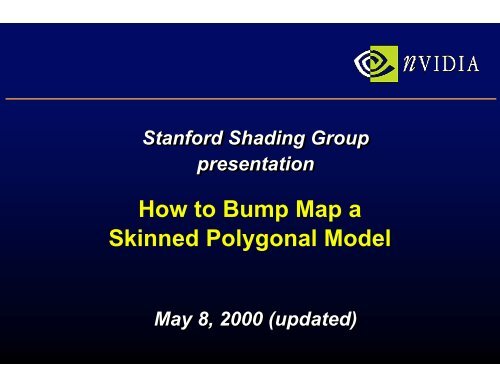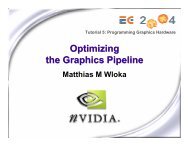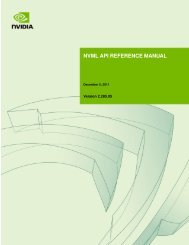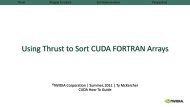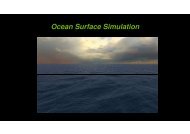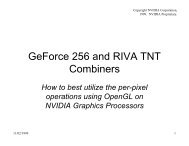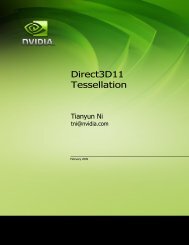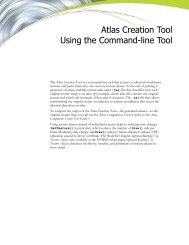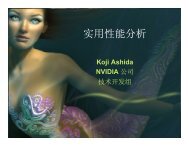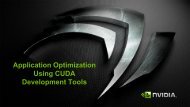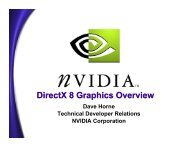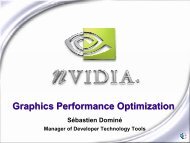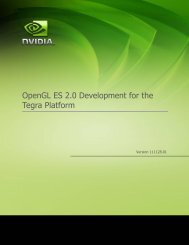How to Bump Map a Skinned Polygonal Model - NVIDIA Developer ...
How to Bump Map a Skinned Polygonal Model - NVIDIA Developer ...
How to Bump Map a Skinned Polygonal Model - NVIDIA Developer ...
You also want an ePaper? Increase the reach of your titles
YUMPU automatically turns print PDFs into web optimized ePapers that Google loves.
Stanford Shading Group<br />
presentation<br />
<strong>How</strong> <strong>to</strong> <strong>Bump</strong> <strong>Map</strong> a<br />
<strong>Skinned</strong> <strong>Polygonal</strong> <strong>Model</strong><br />
May 8, 2000 (updated)
Mark J. Kilgard<br />
Graphics Software Engineer<br />
<strong>NVIDIA</strong> Corporation
Real <strong>Bump</strong> <strong>Map</strong>ping is<br />
Practical and Robust Today<br />
<strong>NVIDIA</strong> GPU bump mapping is fast and good<br />
• Better than “pseudo” bump mapping techniques such as<br />
embossing and DX6 <strong>Bump</strong>Env<br />
• See whitepaper “A Practical and Robust <strong>Bump</strong>-mapping<br />
mapping<br />
Technique for Today’s GPUs”<br />
– in Advanced OpenGL Game Development course notes<br />
– On <strong>NVIDIA</strong>’s web site, www.nvidia.com/<strong>Developer</strong><br />
• I fully expect other hardware vendors <strong>to</strong> expose similar<br />
techniques based on the same basic math
The <strong>NVIDIA</strong> GPU <strong>Bump</strong><br />
<strong>Map</strong>ping Technique<br />
Technique Details<br />
• Requires <strong>NVIDIA</strong> GPU features of GeForce/Quadro<br />
– NV_register_combiners<br />
– EXT_texture_cube_map<br />
– ARB_multitexture<br />
• Tangent space formulation<br />
• Ambient, diffuse, and specular contributions<br />
• Robust filtering, self-shadowing, shadowing, local viewer and light<br />
• Three passes for full effect with texture decal
The “bumpdemo”<br />
Torus Example<br />
A nice shiny bump mapped <strong>to</strong>rus
Ana<strong>to</strong>my of the technique<br />
Three passes (or just two if no specular)<br />
× +<br />
diffuse<br />
decal<br />
specular
The Big Issue<br />
Can I bump map more than a <strong>to</strong>rus<br />
• The <strong>to</strong>rus has the advantage of having a nice parametric<br />
representation for orienting tangent space<br />
– partial derivatives in terms of parametric variables exist<br />
• Games tend <strong>to</strong> use ad hoc polygonal models<br />
– no explicit parametric basis available<br />
– but game models do have textured decal “skins”<br />
– Insight: infer an ad hoc tangent space from the model’s<br />
mapping between vertices and skin texture coordinates!
<strong>Skinned</strong> <strong>Polygonal</strong><br />
<strong>Model</strong>s<br />
Example: Quake 2 models in the “.md2” format<br />
• Decal skin texture, typically 128x128 linear filtered<br />
• Shared vertex list<br />
– each vertex has (s,t) texture coordinate in<strong>to</strong> the skin<br />
• A set of key frames<br />
– each triangle is three vertex indices<br />
– each frame vertex is (x,y,z) and a quantized normal<br />
• Low polygon count, usually 400-800 polygons per model
Quake 2 <strong>Model</strong>s<br />
Piece by Piece<br />
<strong>Model</strong> Key Frames<br />
Quake 2 interpolates between key frames
Quake 2 <strong>Model</strong>s<br />
Piece by Piece<br />
Knight model’s decal skin<br />
Texture coordinates map<br />
triangles <strong>to</strong> skin.<br />
Note clever packing of<br />
decal skin. Only half<br />
face because triangles<br />
“mirror” the face.
Standard Quake 2<br />
<strong>Model</strong> Rendering<br />
Texture key-frame with decal skin<br />
+<br />
Key-frame<br />
model<br />
geometry<br />
Decal<br />
skin<br />
Result
GPU <strong>Bump</strong>-mapped<br />
Quake 2 <strong>Model</strong> Rendering!<br />
<strong>Bump</strong>-map map model with bump, gloss, & decal skin<br />
<strong>Bump</strong><br />
skin<br />
+<br />
Key-frame<br />
model<br />
geometry<br />
Decal<br />
skin<br />
Gloss<br />
skin<br />
WOW!<br />
Result
Quake 2 <strong>Bump</strong> <strong>Map</strong>ping<br />
Rendering Passes<br />
× ) + (<br />
×<br />
( ) + (<br />
) =<br />
Diffuse<br />
Decal<br />
Specular<br />
Gloss<br />
Final result!
More <strong>Bump</strong>-mapped<br />
Knight Examples<br />
Different light positions and key-frames<br />
All lighting including specular is computed per-fragment!
<strong>Bump</strong> <strong>Map</strong>ping<br />
<strong>Model</strong>s<br />
Viva la difference
What is tangent space<br />
Very important concept<br />
• It is a coordinate space that varies over a rendered object<br />
• Assumes the (unperturbed) surface normal is always (0, 0, 1)<br />
– but that’s not enough <strong>to</strong> define a coordinate system<br />
– needs a tangent vec<strong>to</strong>r in the plane of the surface <strong>to</strong> orient<br />
the coordinate system<br />
• Tangent space is very convenient for lighting with a<br />
perturbed normal<br />
– very good for bump mapping
More about tangent space<br />
Normals, tangents, and binormals<br />
• Say the surface is defined by a bivariate vec<strong>to</strong>r parametric<br />
equation, (x, y, z) = F(u, v)<br />
• The tangent is the normalized vec<strong>to</strong>r (∂x/(<br />
∂u,<br />
u, ∂y/<br />
y/ ∂u,<br />
u, ∂z/<br />
z/ ∂u)<br />
u)<br />
• The normal is the cross product of the tangent vec<strong>to</strong>r and the<br />
normalized vec<strong>to</strong>r (∂x/<br />
∂v,<br />
v, ∂y/<br />
y/ ∂v,<br />
v, ∂z/<br />
z/ ∂v)<br />
v)<br />
• The binormal is the cross product of the tangent and normal<br />
• The tangent, binormal, and normal form an orthonormal basis<br />
– in English, that’s s a coordinate system
Parametric Approach<br />
<strong>to</strong> Tangent Space<br />
Forming tangent space<br />
• It is easy with an explicit parametric representation<br />
– such as a <strong>to</strong>rus<br />
• Just compute the vec<strong>to</strong>rs from the previous slide from the<br />
parametric representation<br />
• To be practical, we just compute a tangent space basis at<br />
vertices<br />
– assumes reasonable tessellation around curvature
Tangent Space Basis<br />
is a Gateway for Vec<strong>to</strong>rs<br />
Object-space vec<strong>to</strong>r <strong>to</strong> tangent-space<br />
Ltx Lty Ltz =<br />
Lox Loy Loz<br />
Tx<br />
Bx<br />
Nx<br />
Ty<br />
By<br />
Ny<br />
Tz<br />
Bz<br />
Nz<br />
<strong>How</strong> <strong>to</strong> transform a light vec<strong>to</strong>r in<br />
object space <strong>to</strong> tangent space
<strong>Skinned</strong> <strong>Polygonal</strong> <strong>Model</strong>s<br />
Each vertex consists of<br />
• (x, y, z) object-space position<br />
• corresponding (s, t) on the skin texture<br />
• And each triangle in the model has three such vertices<br />
Insight!<br />
• Per polygon, compute the following plane equations<br />
–AA 0 x + B 0 s + C 0 t + D 0 = 0<br />
–AA 1 y + B 1 s + C 1 t + D 1 = 0<br />
–AA 2 z + B 2 s + C 2 t + D 2 = 0
Compute Partial Derivatives<br />
form Polygon Plane Equations<br />
Make a per-polygon polygon tangent and binormal<br />
• tangent is normalization of (∂x/(<br />
∂s,<br />
s, ∂y/<br />
y/ ∂s,<br />
s, ∂z/<br />
z/ ∂s)<br />
s)<br />
– or normalization of ( -B 0 /A 0 , -B 1 /A 1 , -B 2 /A 1 )<br />
• binormal is normalization of (∂x/(<br />
∂t,<br />
t, ∂y/<br />
y/ ∂t,<br />
∂z/<br />
z/ ∂t)<br />
t)<br />
– or normalization of ( -C 0 /A 0 , -C 1 /A 1 , -C 2 /A 1 )<br />
• normal is the cross product of the tangent and binormal<br />
– important! you need <strong>to</strong> invert the sign if the area of the<br />
triangle in texture space is opposite of the area of the<br />
triangle in object space
Apply the GPU <strong>Bump</strong><br />
<strong>Map</strong> Technique<br />
The approach<br />
• Compute tangent space on a polygon-by-polygon basis<br />
• To match the per-vertex lighting on flat surface resize the<br />
normal, binormal, and tangent vec<strong>to</strong>rs <strong>to</strong> match the model’s<br />
per-vertex normal in tangent space<br />
• Use this 3x3 matrix <strong>to</strong> transform object-space light and half-<br />
angle vec<strong>to</strong>rs in<strong>to</strong> object space<br />
• Perform the GPU bump map technique
Painting the<br />
<strong>Bump</strong> Skin<br />
Example for the knight<br />
• Same <strong>to</strong>pology as decal skin, easy-<strong>to</strong>-author<br />
author<br />
<strong>Bump</strong> skin height-field<br />
Decal skin
Warning about<br />
Pre-lit Decal Skins<br />
Most Quake 2 decal skins are “pre-lit”<br />
• Skins for bump mapping should encode materials, not colors<br />
– because bump mapping supplies the per-pixel pixel lighting!<br />
– so eliminate pre-lighting from decal skins<br />
– otherwise, you get double lighting
Decal Skin<br />
Comparison<br />
Pre-lit skins versus non-pre-lit skins<br />
Original pre-lit knight<br />
decal skin<br />
Modified “un-lit” knight decal<br />
skin for bump mapping
Gloss <strong>Map</strong> Modulates<br />
Per-fragment Specular<br />
Alpha channel of decal hides “free” gloss map<br />
• Per-fragment modulation of specular pass<br />
• Used on knight <strong>to</strong> avoid shiny<br />
face, belt, and cloth<br />
• Same skin <strong>to</strong>pology as other maps<br />
Decal<br />
skin<br />
Gloss<br />
skin
Assumptions<br />
Things that should be approximately true<br />
• The normal and binormal are not guaranteed <strong>to</strong> be<br />
orthogonal<br />
– but hopefully will be close since artists would otherwise be<br />
working on con<strong>to</strong>rted skins (so ok assumption)<br />
• <strong>Model</strong> is reasonably tessellated, particularly in regions of<br />
high curvature change (usually ok assumption)<br />
• Good continuity of light and half-angle angle tangent-space vec<strong>to</strong>rs<br />
across polygons (poor assumption)
Tangent Space<br />
Vec<strong>to</strong>r Continuity<br />
Visualizing this assumption, not that good<br />
tangent space light vec<strong>to</strong>r<br />
tangent space half-angle angle vec<strong>to</strong>r
Worst-case Tangent<br />
Vec<strong>to</strong>r Discontinuities<br />
Change across polygons<br />
A<br />
B<br />
polygons in skin texture space<br />
A<br />
B<br />
polygons in object space<br />
arrows indicate increasing t texture coordinate
Tangent Continuity<br />
Solutions<br />
Reorient and repack all polygons in skin textures
<strong>Bump</strong>-mapped <strong>Skinned</strong><br />
<strong>Polygonal</strong> <strong>Model</strong>s<br />
More examples
Credits<br />
Where credit is due<br />
• Sim Dietrich and Doug Rogers invented the idea of creating<br />
an ad-hoc tangent space from skinned polygonal models<br />
• Cass Everitt developed the bump skin re-packing technique<br />
• Quake 2 .md2 models designed by<br />
– faerie model, Brian Collins<br />
– alien model, RichB<br />
– Boba Fett model, Dan Bickell<br />
– Perelith Knight model, James Green


